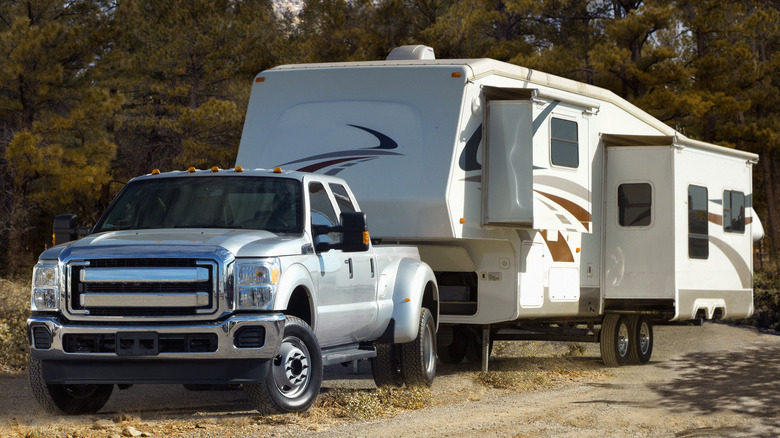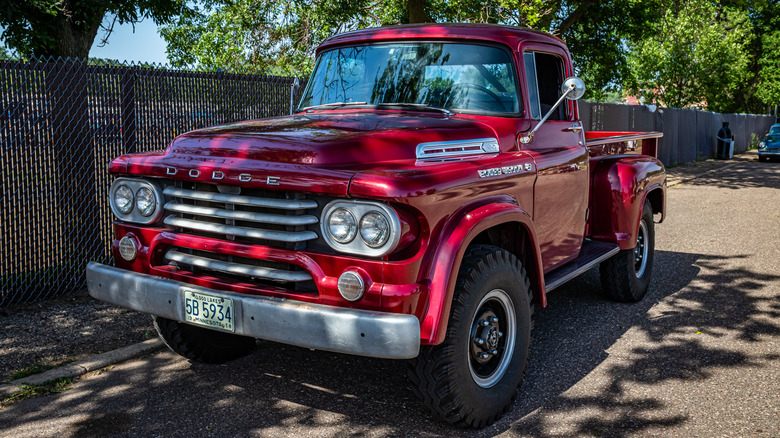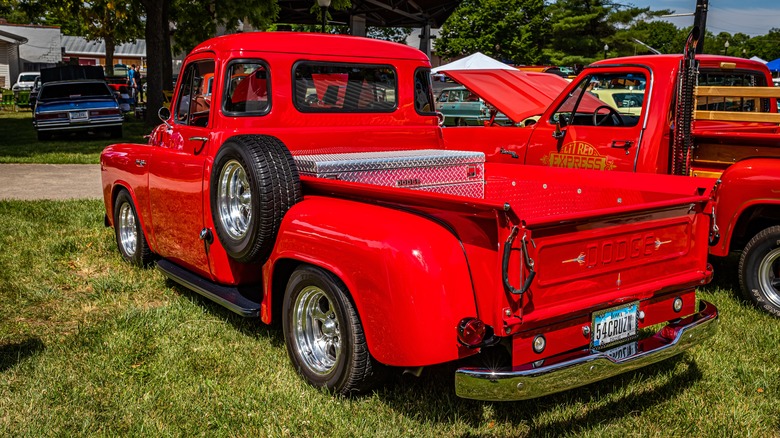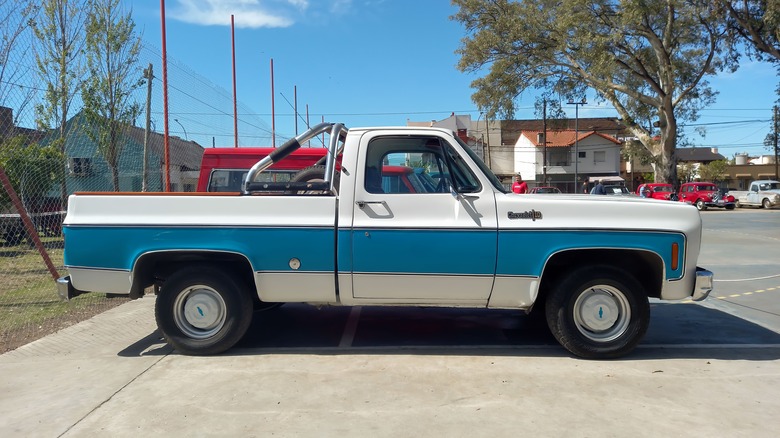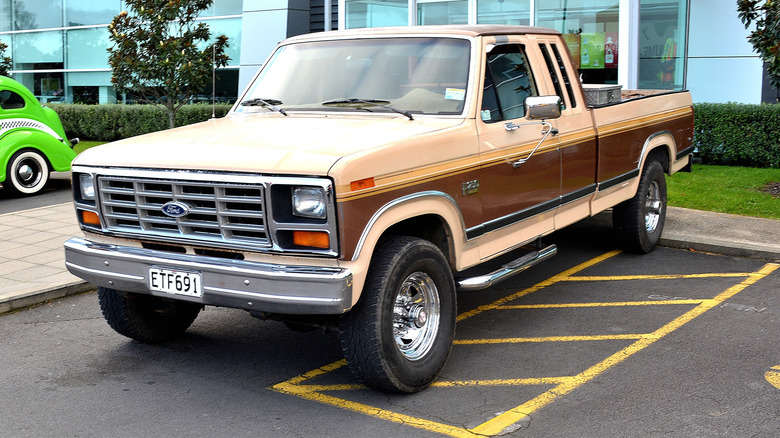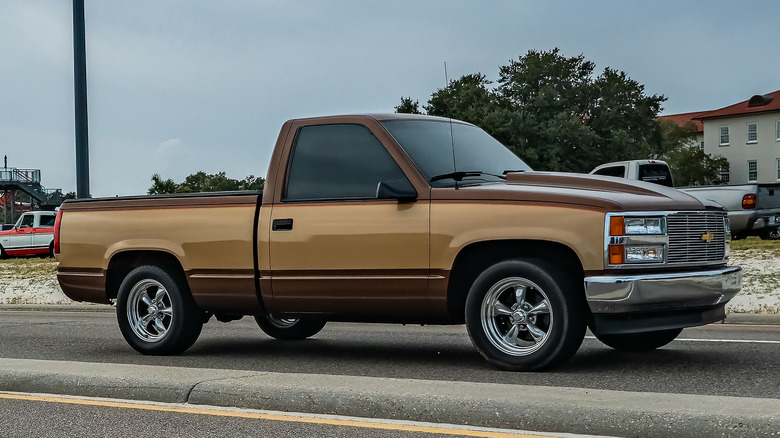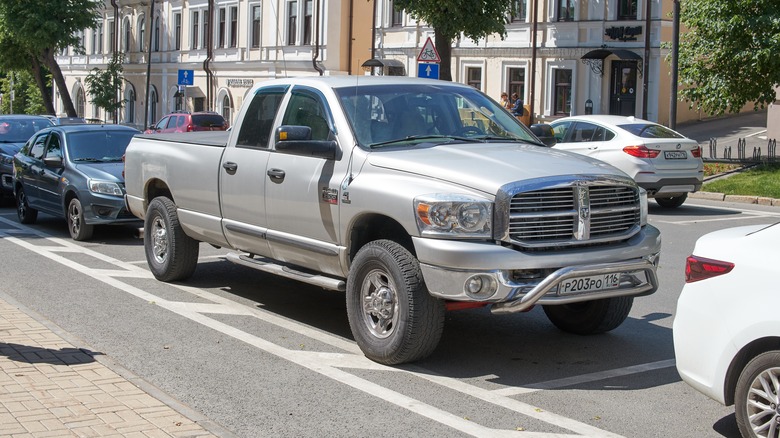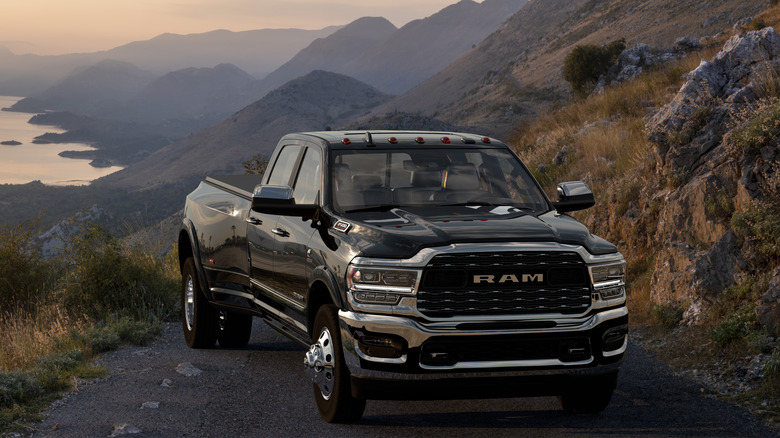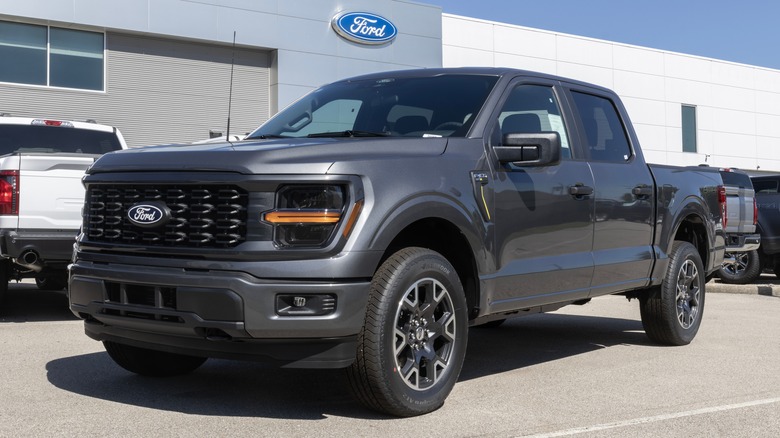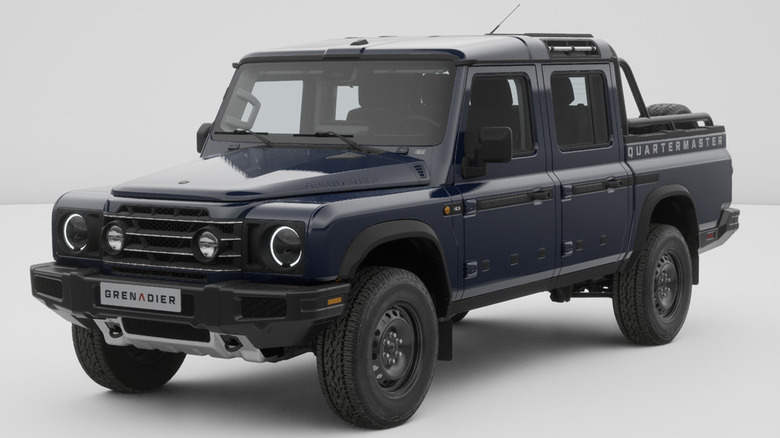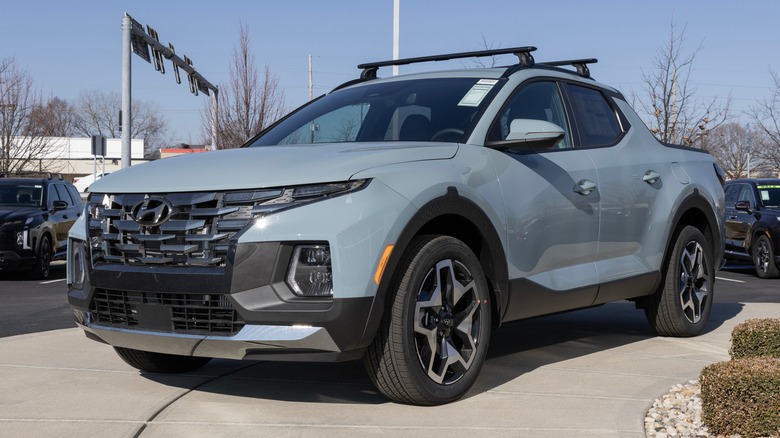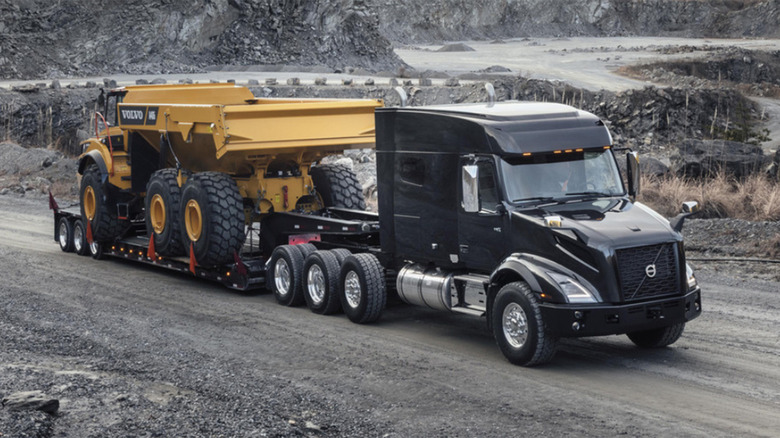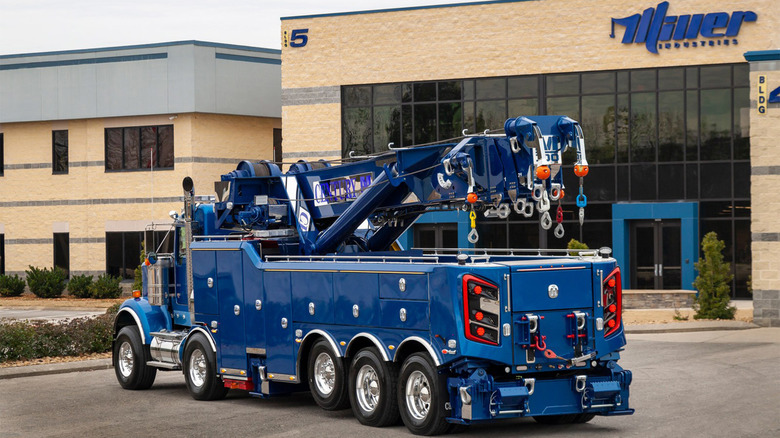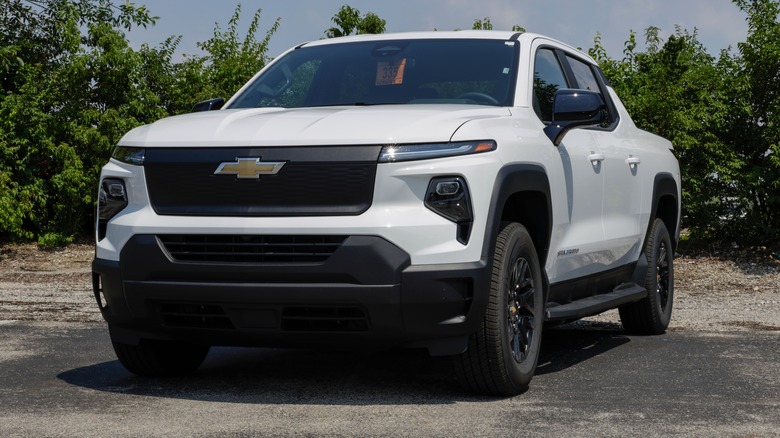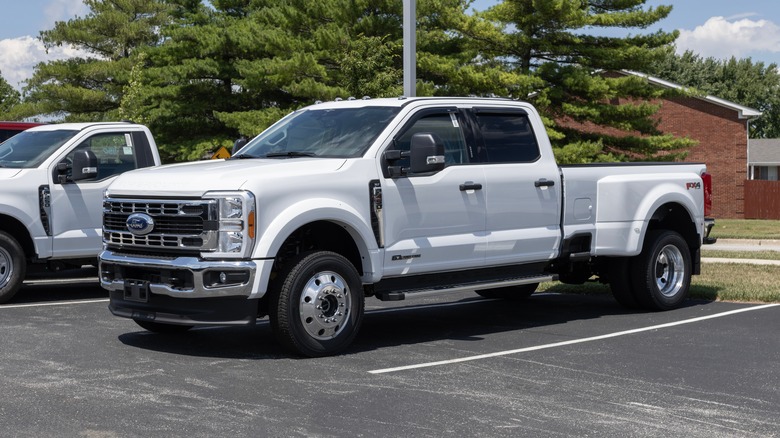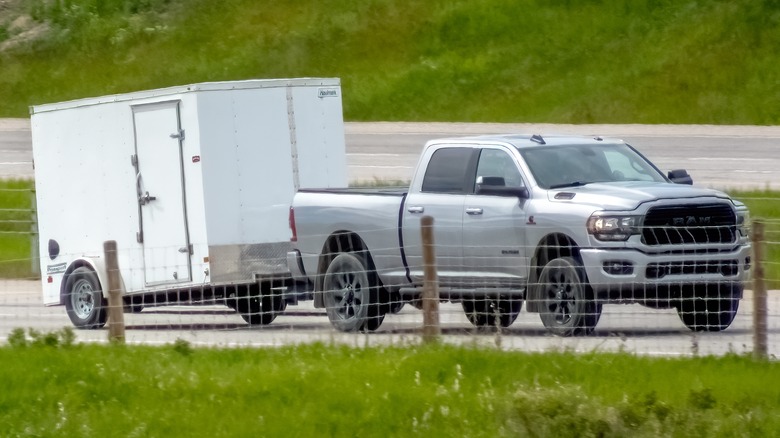15 Of The Best Trucks Ever Made For Maximum Towing Capacity
Two of the most common uses for pickup trucks are hauling and towing. Each manufacturer tackles this challenge in a different way and some truck makers do it better than others. There are also some misconceptions about towing. For example, torque and wheelbase length are often more important than straight horsepower. That's why some of the most powerful trucks on the market also tend to have the highest possible torque.
So, over the years, automakers have done all sorts of things to ensure that their trucks can haul the things that their owners want them to haul. For consumer trucks, it's mostly just elongating the wheelbase and putting in stronger engines. However, automakers will also make vehicles dedicated to the craft of hauling and towing. You've seen examples of these all over the place in the form of semi trucks and tow trucks. So, with all the trucks out there, here are some of the best trucks ever built for towing and hauling, based on their respective gross vehicle weight rating (GVWR) and payload capacities.
1940s Dodge Power Wagon
Automakers briefly ceased building consumer vehicles during World War II to help with the war efforts, so we'll start our list in the late 1940s with the Dodge Power Wagon. Automakers had learned a lot from when they made vehicles for the military and some of that technology came back to consumers after the war, and the Dodge Power Wagon is a great example of this.
Just how powerful was the Dodge Power Wagon? The 1940s and '50s models boasted a GVWR of between 7,600 and 8,700 pounds depending on the model, which was quite high for any truck back in those days. Some models even came equipped with a boom and winch for heavier duty tasks like posthole digging. Dodge ultimately adjusted the size and shape to use it for a variety of tasks such as being a firetruck. It was undoubtedly one of the most powerful trucks of the 1940s.
1950s Dodge C-Series Pickup
Dodge continued its dominance into the 1950s with the Power Wagon but also had the C-Series Pickup truck. Much like the Power Wagon, the C-Series was altered in a variety of ways to do a variety of tasks. These trucks were fairly powerful in their base configurations, but the numbers get up there once you look into the specialized versions of the truck. There were multiple models of the C-Series truck as well, including the C1, C3, C4, Town Panel, Town Wagon, and several others.
For example, the job-rated variants of the Dodge C-Series truck used the Chrysler 331 Hemi engine, which gave them a GVWR of 9,000 pounds. Generally speaking, most of the ones with the Hemi were built for work, so most examples include things like utility trucks, ramp trucks, and similar vehicles like that. You likely won't find any base model trucks with that GVWR, but the job-rated variants were easily some of the most powerful trucks of the 1950s.
1960s and '70s Chevy C20
Once the 1960s got into full swing, other truck makers started getting in on the action. Two great examples of that are the C10 and C20 trucks from Chevy, which enjoyed some great success in the 1960s and 1970s. The C10 was a half-ton truck while the C20 was a three-quarter ton truck, so the C20 was clearly the more powerful of the two, so we'll focus on that one.
Promotional materials for the C20 boasted a GVWR of up to 10,000 pounds depending on the model. You needed the largest, longest, and most powerful variant of the consumer C20 to get those numbers but they did exist. Chevy also made special versions for work trucks. Those were vastly more powerful, boasting GVWR as high as 65,000 pounds. Such vehicles were essentially box trucks, dump trucks, and other similar work trucks built based on the C20, so they're not technically the same style of truck. However, even by today's standards, those are big numbers.
1980s Ford F-250
By the 1980s, things had changed for the auto industry in the U.S. New emissions standards were taking hold, and automakers had some initial troubles making engines that were powerful and also adhered to the Clean Air Act from the 1970s. However, automakers eventually figured it out and the 1980s saw new growth in power from trucks. Among those was the Ford F-250, which was one of the most powerful trucks of the 1980s.
In 1985, a properly equipped Ford F-250 had a GVWR of 8,600 pounds with a payload capacity of 5,000 pounds. Those figures could be improved to 10,000 pounds and potentially beyond with the use of several additions, including Ford's Super Cooling, a handling and suspension package, and a proper tow hitch. Regardless, that put the Ford F-250 in the upper echelon of trucks from that era. Chevy also kept up with trucks with GVWRs as high as 10,000 pounds in 1989.
[Featured image by GPS 56 via Wikimedia Commons | Cropped and scaled | CC BY-SA 2.0]
1990s Chevy 3500 and Ford F-350
In the 1990s, Chevy and Ford pulled to within a margin of error of each other, so when looking at pickup trucks for towing from that decade, those are the two brands you went for. The 1990s is also when automakers started posting their tow numbers, so we'll be switching from GVWR to tow numbers for the rest of the article. So, for the 1990s, if you wanted the highest tow ratings, you either went with the Chevy 3500 HD or the Ford F-350.
For the Chevy 3500 HD, the maximum tow rating was 10,000 pounds in 1995, a figure it carried through the end of the decade. The Ford F-350 matched these numbers and them some, with some models capable of towing up to 12,500 pounds. Like most trucks, you do need the proper equipment, though. For the Chevy, you needed a special trailer package, a transmission oil cooler, and you have to have one with a 4.56:1 axel ratio. The Ford had similar requirements.
2000s Dodge Ram 2500 Quad Cab
When the new millennium came around, Dodge started playing the tow rating game with Chevy and Ford, and actually managed to beat them at it. Dodge's champion was the Ram 2500, specifically in the Quad Cab configuration. That model came with a longer wheelbase and all of the optional packages available to hit the highest tow ratings. It also came with a 6.7-liter Cummins turbo diesel engine that put up pretty good numbers too.
At its absolute maximum, the 2009 Dodge Ram 2500 Quad Cab was capable of towing a monstrous 13,550 pounds and carrying a maximum payload capacity of 3,210 pounds. To get that number, you had to have the Quad Cab with the turbo diesel and all of the available tow packages. By contrast, the Ford F-250 topped out at 12,500 pounds while the Chevy 2500 came close with 13,000 pounds. Chevy achieved its number with a regular gas engine instead of a diesel, but Dodge still scored the win overall.
2010s Ram 2500 4X2
The 2010s are the most recent decade, so we start to see trucks much closer to today's standards versus the standards of yesteryear. As it turns out, Stellantis came back for a second victory in the 2010s with the Ram 2500 4X2. By this point, Ram had spun off from Dodge and was its own brand, so unfortunately, Dodge doesn't get to claim two victories here. The story is otherwise much the same. Ram tossed a 6.7-liter Cummins diesel into these trucks and they could tow for days thanks to it.
With the Cummins diesel and the proper equipment, the Ram 2500 4X2 was capable of towing 19,780 pounds. Even without the diesel, the 6.4-liter V8 Hemis that Ram put into these trucks maxed out at 17,730 pounds. It can go even higher with a gooseneck hitch or a 5th-wheel addition. The Ford F-250, meanwhile, maxes out at 15,000 pounds but can similarly add thousands of extra pounds with similar add-ons.
Full-size Champion — 2024 Ford F-150
The full-size truck segment is the most popular truck segment in the U.S. It's also known as the half-ton segment since trucks in that segment have to capable of carrying at least a half a ton of material in the truck bed. For this segment, the Ford F-150 is the king of the mountain in terms of towing capacity. In addition to its high towing capacity, Ford has spent the last few years really gussying up their trucks and while that's made them more expensive, they're nicer than they've ever been.
For towing, the 2024 Ford F-150 tows a maximum of 13,500 pounds, which is very respectable for a truck this size. To get it, you'll need the twin-turbo V6 option. Strangely, the V8 can only tow 13,000 pounds while the hybrid F-150 tows a very respectable 12,700 pounds. To be fair, competition in this segment is fierce and the Chevy Silverado 1500 and the GMC Sierra 1500 only lose to Ford by 200 pounds.
Midsize Champion — 2025 Ineos Grenadier Quartermaster
Not a lot of people have heard of Ineos before, so the Ineos Grenadier Quartermaster may be a question mark for a lot of people. This might be because Ineos hails from the United Kindom, where the automaker makes varying trucks and SUVs, many of which are destined for Australian shores. They only began selling cars in the U.S. in 2024. The regular Grenadier is actually an SUV while the Quartermaster is the truck variant. It's not too dissimilar to the GMC Hummer in this regard.
For towing, the Genadier Quartermaster narrowly edges out the rest of the midsize truck segment with a towing capacity of 7,716 pounds but you'll need to add the optional trailer brake controller in order to tow anything. What's interesting is that figure is the same across the entire Grenadier lineup, so you can get that in SUV format as well. The oddly specific tow number works in Ineos' favor here since GMC Canyon and Chevy Colorado both tow 7,700 pounds.
Compact Truck Champion — 2024 Hyundai Cruz and Honda Ridgeline
Compact pickup trucks aren't known for their towing but there are a couple of models that can do it if you need them to. The first is the Hyundai Santa Cruz and the other is the Honda Ridgeline. Both of these trucks are essentially crossover SUVs with a truck bed carved into the back of them, so the fact that they can tow at all is impressive. They won't be able to haul a whole RV, but you can get your boat to the lake pretty easily at least.
We list both trucks together here because they are essentially tied. The Hyundai Santa Cruz can tow a maximum of 5,000 pounds, just like the Honda Ridgeline. The Santa Cruz requires all-wheel drive and the optional trailer brakes installed to get it there as does the Ridgeline. That's enough to tow most automobiles with a lightweight trailer or various weekend toys, which is more than enough for many people.
Semi-truck Champion — Volvo VNX 740
We thought it would be fun to play with big numbers, so we wanted to include a semi-truck on the list. Semis are custom build for hauling monstrous loads from lumber to manufacturing and everything between. The semi-truck with the largest capacity that we could find was the Volvo VNX 740, which is capable of hauling some truly massive things. The VNX comes equipped with a 605-horsepower engine that puts out an astounding 2,050 lb.-ft of torque, which is what gives it the power to haul.
While exact tow numbers aren't available, Volvo says that the truck's GVWR can range from 125,000 to 160,000 pounds stock with ratings of up to 225,000 available with the proper additions. That easily and handedly exceeds the 80,000-pound maximum weight limit on U.S. interstates. States can legally allow more on non-interstate roads with South Dakota and Michigan allowing north of 160,000 pounds on their roads and even heavier loads are allowed with permits. Volvo is equipped to handle those types of loads and more. It's one powerful machine.
Tow Truck Champion — Century M100
It would be a mistake to talk about trucks with high tow capacities and not at least give a nod to the trucks designed specifically to tow things. Among those, the Miller Industries Century M100 reigns supreme. It's a tow truck that is about the length of a standard firetruck with a massive winch that can carry up to 65,000 pounds on its own and drag up to 30,000 pounds of dead weight. The mechanisms are so powerful that the truck comes with specialized winch controls for ease of use.
So how much does it tow? Miller Industries says that the truck is rated to tow 200,000 pounds. To get that, the boom arm has to be retracted to a 30-degree angle. Once it extends, the towing capacity drops fairly dramatically as the truck relies on the boom arm's strength as it extends. Miller Industries had to put some work into the truck to make it do these sorts of things. If you really need to haul something, the M100 can do it.
EV Champion — 2025 Chevy Silverado EV 3WT
EV trucks are starting to become popular and as with any truck, people are curious which one can tow the most. Currently, the champion in the EV truck segment is the 2025 Chevy Silverado EV 3WT. This is, however, likely a function of the Silverado being among the newest EVs with the latest technologies. As of this writing, production for the 2025 Chevy Silverado EV is set to begin in late 2024, so there is still quite a lot that we don't know. However, GM published many of its early specs early so people know what to expect.
Among those specs is a GM-estimated tow rating of 12,500 pounds. That is tops in the segment for now, but it'll likely get pushed up again in the next generation of EV pickups. In fact, one is already in the works as Chevy has said that an EV truck with a 20,000-pound capacity is currently in the works. For now, the Silverado edges out the Rivian R1T and the Tesla Cybertruck, both of which tout 11,000-pound ratings. It's still not as much as a truck with a gas engine, but it's getting pretty close.
The Champion — Ford F-450
If you want the maximum towing in a consumer vehicle, the Ford F-450 is probably the current champion as of this writing. The numbers on it are fairly impressive. The 6.7-liter Power Stroke turbo diesel that Ford uses outputs 500 horsepower and 1,200 lb.-ft of torque, which is how it gets its impressive tow numbers. It's an expensive option, though, as the high-output engine runs you easily into the $60,000 range and trucks can climb over $100,000 quickly when you start adding the extra options.
When it comes to work-oriented vehicles sold to the general public, there are few trucks that can compete with the Ford F-450. When it's fully maxed out and includes a gooseneck trailer, the F-450 can tow 40,000 pounds. That's higher than the competition by a solid amount. Additionally, the truck has a maximum payload capacity of 8,000 pounds. With the average car weight in 2022 being just over 4,000 pounds, that means you can stack two average cars on top of the F-450 and it'll still drive forward. The only way to get more towing is to buy a commercial vehicle designed for it.
Fun fact — A Toyota Tundra once pulled a Space Shuttle
As you can see from our list, U.S. automakers dominate the truck industry. However, that isn't to say that trucks from other locales are bad, they just don't have the biggest numbers of the spec sheets. One great example of this is the 2012 Toyota Tundra that towed a space shuttle. The shuttle weighed nearly 300,000 pounds and required a special tow trailer for the Tundra to drag it 12 miles to its new home at the California Science Center. That is mighty impressive for a truck rated for 10,500 pounds.
Feats like this have happened several times. A Chevy truck once towed an American flag that measured 40-feet by 80 feet. Ford beat that with a 45-foot by 92-foot flag later that same year. The GMC Sierra 2500 once towed a trailer at a record of 141.99 MPH. With special equipment and some know-how, it is possible to wildly exceed the weight limits most trucks have and there are many non-U.S. trucks that have towed a great deal of weight over the years.
How we judged these trucks
Rating these trucks was a bit of a difficult task. Tow ratings weren't as common in earlier decades as they are today as manufacturers didn't really think to market their trucks for their towing capacity. So, for earlier years, buyers had the gross vehicle weight rating — or GVWR — to tell them how powerful any given truck was. It wasn't until the 1990s that the Society of Automotive Engineers (SAE) came together to create a standardized tow rating.
So, for this list, we decided to bounce around between GVWR and tow ratings depending on which years the trucks were available. The GVWR is the maximum load capacity of the vehicle, so it does correlate with how much the vehicle can tow. GVWR also correlates to other things like payload capacity and other capabilities so it's not quite a one-to-one ratio. For earlier trucks, we'll use GVWR to describe how much they could tow and then swap to tow ratings in later trucks when they became available.
